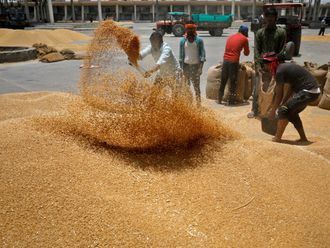New Delhi: Every now and then, secret tunnels discovered in India have fascinated both historians and the public.
Most of these tunnels were used as escape routes by emperors and rulers of the country at some point, or were just walkways for the guards to march faster.
The recently unearthed tunnel below the floor of Delhi Secretariat (Legislative Assembly) building, near Civil Lines in north Delhi, is believed to be more than a century old.
Speaker of the Legislative Assembly, Ram Niwas Goel, told Gulf News, “I had been hearing about the existence of the secret tunnel from the staff and decided to get to the bottom of it. Literally.”
On digging the portion beneath the floor of the parliamentary hall, the seat of the Delhi government, a shallow chamber, approximately 1.5 metres deep and 4.5 metres wide was discovered — along with another smaller passage. Interestingly, the 8-metre long access route leads to the seat of the Speaker.
The entrance of the tunnel is kept hidden under the green carpet that covers the entire floor of the chamber. But on uncovering a square patch, the entrance to the secret tunnel can be seen. The administration has now put a wooden panel with a glass covering and lit up the interior of the tunnel.
On entry, one finds brick walls and rubble strewn around. It is not possible to advance much further in the tunnel, as it abruptly comes to a dead end.
“The administration considered it inappropriate to dig the British era tunnel further as, due to construction of several pillars of flyovers and water and sewage lines, excavation could prove risky,” Goel said.
Nevertheless, Goel, an Aam Aadmi Party (AAP) member, has a plan up his sleeves.
“To satisfy the curiosity of the common man, we might consider opening the back gate of the Legislative Assembly building to the public on August 15 [Independence day] and January 26 [Republic Day], so that they can visit the tunnel area. We want to preserve it as reminder of the oppression Indian freedom fighters suffered during the British rule and the sacrifices they made for the country,” the Speaker remarked.
Officials and experts claim the tunnel stretches for about 7km — from Delhi Secretariat to the Mughal era monument Red Fort.
The history of the building, comprising the tunnel, dates back to 1911. Earlier, Calcutta (now Kolkata) and not Delhi was the capital of India. Referred to as the Imperial Legislative Assembly, the council used to meet at Government House, Calcutta. But after the decision by the British rulers to transfer the capital to Delhi, the present Secretariat building was designed by E. Montague Thomas and its construction completed in 1912. It was the first modern building that came up after Delhi was declared the capital.
But after the construction of Parliament House (designed by British architect Edwin Lutyens and Herbert Baker) in 1927 in central Delhi, the Delhi Secretariat building fell into disuse for a long time. It bubbled into activity again in 1952, when Delhi was given an Assembly.
However, mystery shrouds the secret tunnel, as assumptions are made of the adventures that happened inside it.
Goel said: “While the records of the buildings are known to historians, what is lesser known is that during the British rule, the fortified buildings of Red Fort, where the British held political prisoners, had a secret tunnel. Through this very tunnel Indian freedom fighters were ferried to the Secretariat building, which was used as a courtroom. From here, they were taken to a nearby room to be hanged. The room had been locked for over two decades.”
The building is an architectural marvel. The grand square’s archways, round pillars and long corridors provide an insight into the grandeur of the time.
Meanwhile speaking to BBC, historian William Dalrymple was unconvinced of Goel’s theory. Acknowledging that freedom fighters were sentenced to death in the building, Dalrymple, however, felt there was no need for British settlers to build a tunnel merely to transport prisoners, as they had full military control and it was pointless for a mammoth structure like a tunnel to be dug for the purpose.
“They could drive prisoners through the streets without any fear,” he said.
Author of several books, Dalrymple said the tunnel could date back to the First War of Independence, considered the bloodier period of British rule in India, and the great rebellion of 1857. He speculated the land where the Delhi Secretariat is built was a key battleground and the tunnel a grisly reminder of the anti-colonial uprising that was put down brutally.











